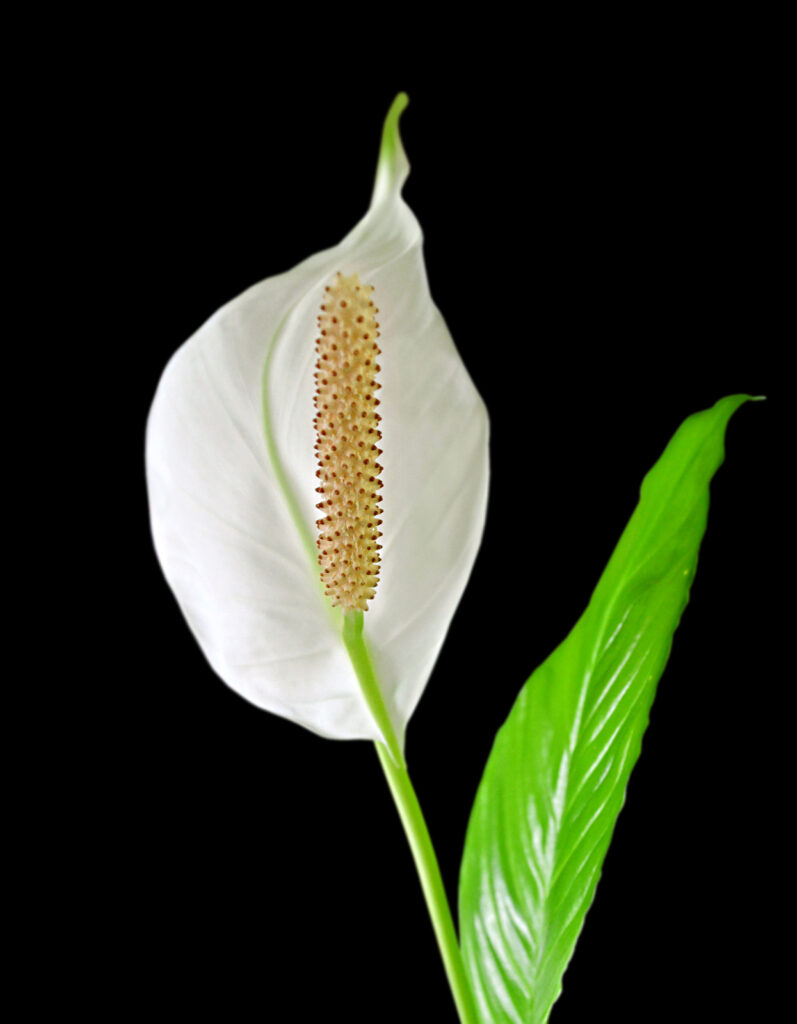Spathiphyllum–commonly called Peace lily–is a graceful plant with shiny, green leaves and beautiful hooded white flower spikes. Spathiphyllum is generally problem-free and easy to grow.
Spathiphyllum is a tropical perennial. It is often grown indoors. The leaves are glossy green and oblong. the flowers are white, fragrant, and tiny. Flowers bloom along a tail-like structure called a spadix. The spadix is surrounded by a white or green bract called a spathe. Flowers appear in spring and summer.
Spathiphyllum is a genus of 36 species of rhizomatous evergreen perennials. The genus is native to damp tropical forests in Indonesia, the Philippines, and tropical North, Central, and South America.
Get to know Spathiphyllum
- Plant type: Evergreen perennial
- Growing Zones and range: Zone 14-15
- Hardiness: Tender
- Temperature: Temperature not less than 55°F (13°C); keep out of cold drafts
- Light: Outdoors in shade; the direct sun can burn the leaves; indoors low to medium, indirect light
- Height and width: Up to 6 feet (2m) tall in the landscape; 12 to 24 inches (30-60cm) tall and wide as a houseplant
- Foliage: Large, glossy, sword-like leaves 6 inches (15cm) or longer growing from a common base
- Flowers: 3 inches (7.6cm) white hooded flower spikes with golden centers
- Bloom time: Occasionally throughout the year; flowers last for 6 weeks
- Uses: Houseplant; accent plant
- Common name: Peace lily, spathe flower
- Botanical name: Spathiphyllum wallisii
- Family: Araceae
- Origin: Tropical Indonesia, Philippines, North, Central, and South America
Where to plant Spathiphyllum
- Grow Spathiphyllum in low to medium light.
- Grow Spathiphyllum in humus-rich, well-drained soil outdoors. Indoors, grow Spathiphyllum in an all-purpose potting mix enriched with peat moss.

How to water and feed Spathiphyllum
- Keep the soil just moist; avoid wet soil.
- Fertilize Spathiphyllum 2 to 3 times a year. Too much fertilizer can cause leaf tips to brown.
Spathiphyllum care
- Place the plant on a tray with pebbles and water to encourage humidity.
- Wipe leaves once a month with a damp cloth to keep the leave glossy and healthy.
- Repot Spathiphyllumn in early spring as needed.
- Frost will kill Spathiphyllum.
Growing Spathiphyllum as a houseplant
- Grow Spathiphyllum where the temperature is warm, light is bright and humidity is medium to high.
- Plant in a soilless growing medium and keep it evenly moist at all times.
- Fertilize every two weeks from spring through fall.
- dust or wash the foliage frequently.
Spathiphyllum pests and diseases
- Spathiphyllum can be affected by root rot, leaf spots, and bacterial soft rot.
Spathiphyllum propagation
- Remove and repot offsets or divide clumps in spring.
Spathiphyllum varieties to grow
- Spathipyllum clevelandii, white anthurium. Grows to 36 inches tall; narrow, 12-inch leaves; oval 6-inch white spathe and a 2-inch spadix.
- S. x hybridum. Narrow oblong, 10-inch leaves grow to 30 inches tall; spathes are large and white with green midribs and undersides. Cultivar ‘Mauna Loa’ is compact and grows to 3 feet tall; dark green leaves and 5-inch spathes.
- S. wallisii. Grows 26 inches tall and 20 inches wide; elliptic dark green leaves with wavy margins; oblong fragrant white spathes to 7 inches long.
Spathiphyllum — Peace Lily frequently asked questions
Q: What temperature is best for peace lily?
A: Peacy lily needs warm temperatures, a minimum of 55°F in winter.
Q: What kind of light should the peace lily have?
A: Give peace lily semi-shade in summer and bright light in winter. Strong sunlight will damage the leaves.
Q: How should I water peace lily?
A: Keep the potting medium moist at all times, but not wet. Reduce watering in winter. Mist the leaves frequently to maintain proper humidity.
Q: How often do I feed my peace lily?
A: Fertilize peace lily every two weeks from spring through fall. Use an all-purpose indoor plant food.















